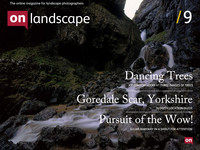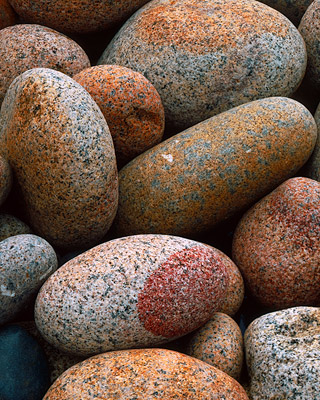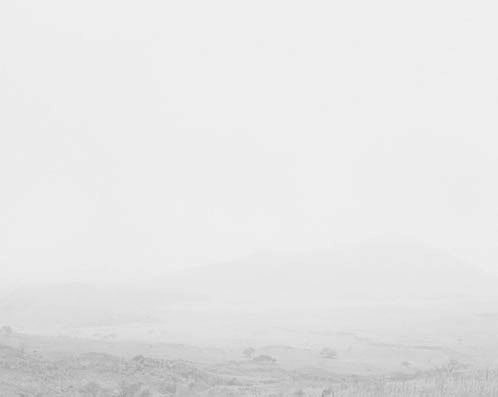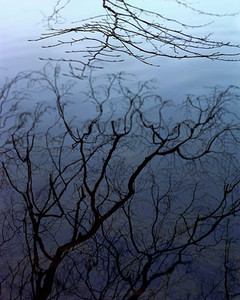Julian Barkway questions the dominance of the dramatic image

Julian Barkway
Iam what can best be described as an enthusiastic amateur photographer. I try not to follow fashion or trends and I’m never happier than shooting with my 5x4 camera on good old sheet film. The intimate landscape is what interests me which is, perhaps, surprising given that I have been based in Switzerland for a number of years. My favoured habitat is the bottom of a rocky gorge but I do occasionally emerge to shoot the bigger vista. And I do occasionally shoot digital - but shhh, don’t tell anyone! website
We've all seen them on photo-sharing sites: images of grand vistas with strong colours, dramatic perspectives, apocalyptic lighting. We've read the comments: "wow, great shot", "wow, amazing colours", "stunning composition", "I'm blown away", etc., etc., etc. We may have seen these images walking away with the top prize at our local camera club's competitions. But hold on a moment. Aren't they all a little bit, well, samey? Don't they all seem to use similar techniques, effects and compositional devices? Haven't we seen the same handful of famous locations before?
Photography is a means of communication and, like other means of communication, depends on mutual understanding of a common language. So, what are all these very similar images trying to say? What is their message? It seems to me that mostly what the photographers are saying is, "I've seen images that sort of look like this one and I think they're fantastic. And, what's more, I can do it too!" When everyone is shooting much the same few locations from much the same viewpoints in much the same light, you have to ask: where is the personal vision? Where's the individual voice? Has photography come down to using some tried-and-trusted formula to elicit the hoped for single syllable response, a simple and basic utterance of 'wow!'?
Well, I certainly hope it hasn't. There are still photographers - both amateur and professional - who seek to communicate using a visual language composed of more than mere monosyllables; who can create images of the landscape that are thoughtful, provocative, evocative, mysterious, beautiful and which speak to the viewer on many levels. So why is it that so many landscape photographers (mostly, but not entirely, in the amateur world) are content to reproduce the Standard View and do not seek to show something a little more personal?
Recently, I went to an exhibition of work by the Swiss fine-art photographer, Christian Vogt.Vogt is not a landscape photographer per se but he does use landscape as subject-matter when it suits his artistic goals. Walking around the exhibition, I encountered two or three large prints which, from a distance, seemed totally white and devoid of anything that might loosely be called 'photography'. Thinking this was some kind of ironic statement, I walked closer and as I did so, intriguing details emerged from the seemingly blank sheets of paper. They were Alpine scenes in fog - part of Vogt's 'Mist' series. Not so much low contrast as practically no contrast - just shades of pale grey. I remember being utterly captivated by the emptiness of these images and how brilliantly executed they were. Moving on, in another part of the gallery I found images from the same photographer's 'Naturräume' (natural spaces) series - huge monochrome panoramas of forest scenes, rich with detail and essentially chaotic; the total antithesis of the 'Mist' prints, in fact. Although the enormous scale of the prints was impressive, it was the careful composition that drew my interest. There was a great attention to detail and the way tones and compositional relationships were handled made the images appear almost three dimensional. You felt you could, as the old cliché has it, step into the scene and become part of the picture.
What struck me most about these images, however, was not the mastery of their execution so much as how unnecessary it is for an image to have the 'wow' factor to be interesting. Apart from their sheer size (something of a trend in contemporary 'fine art' photography), there was nothing intrinsically impressive about them. Nothing that made me gasp with admiration. In fact, they were 'anti-wow' images. Like classical music or modern jazz, the images demanded that the viewer make an effort to meet the artist halfway. They were images that make you think for yourself.
Contrast this with what we see daily on all our favourite photo-sharing websites. Images which are designed with the goal of making the viewer go 'wow!' don't generally speak quietly or invite concentration. As in the world of advertising, it's about a simple message shouted very loudly. Advertisements are, by and large, not designed to be subtly ambiguous or to be lingered over. They are about making the maximum impact in the shortest amount of time. They are instantly forgettable even if they have already done their job of carefully implanting a message in our minds.
Of course, it should not be forgotten that 'wow' images, when done well, are highly commercial and artists such as Peter Lik have built profitable businesses out of this style. If you have customers to please and a bank manager to appease then what the customer wants the customer should get. But what if you are taking images for yourself or for an audience of your peers? Differentiating your work from that of others makes sense. If the ultimate goal is to develop your own style, how can it help repeatedly copying a style that is all too ubiquitous?
So why is it that so few photographers seem to be creating images which demand that viewers put in a bit of effort to understand them? Isn't it also a good feeling to have someone lingering over your work, finding new levels of meaning or more subtle details with each passing minute? Perhaps, in our modern age of fast food, instant sharing of every experience with (potentially) many thousands of people and, let's face it, fast photography we have lost the skill of simply taking the time to appreciate art. If it doesn't stimulate in the first few milliseconds then it's discarded in favour of the next image. After all, there are thousands more every day.
I feel we are short-changing our potential audience. It's as if landscape photographers want to be anonymous. If we want people to think of photography as art then isn't making a statement that is not only personal but complex and subtle to be desired over bright colours and melodramatic effects? In short, if you have something worthwhile to say, then make sure it comes across in your photographs. I'm put in mind of that scene in the Monty Python film, 'Life of Brian', where Brian is trying to get the large crowd of followers gathered in front of his home to disperse. He is imploring the crowd to think for themselves. "You are all individuals!", he shouts and then the crowd chants with one voice, "Yes, we are all individuals". Everyone wants to be an artist yet also seems to be forgetting that the phrase 'be true to yourself' lies at the heart of being an artist.
So, if people say you should use the very widest of wide-angle lenses, then use a telephoto; if they say you should only photograph landscapes at dawn and dusk, go out at midday; don't use golden light, shoot in the rain; find your local area of beauty or personal significance instead of travelling to the same few locations as everyone else; shoot landscapes on a more intimate scale, not just the grand vista. Above all, make people think about your photography! Give them a reason to remember your work. Make them want to linger over each individual image. Make them say, 'this reminds me of my childhood' or 'this is rather melancholy' or 'you know, I've never seen trees that way before' or even just 'hmmmm'. Anything, in fact, but 'wow!'
Julian Barkway is a landscape photographer from the UK who is currently living in Switzerland. Working with a 5x4 camera and a full frame DSLR in the mountains has created a wonderful portfolio of pictures that I recommend you take a look at. His main website is at http://www.quiet-light.com/ and you can see his regularly updated Flickr stream here. Many thanks to Julian for this article..
- Mist 4 – Christian Vogt
- Naturräume (Natural Spaces) 4 – Christian Vogt












